
The 2019 Leadership Track: Part 1
Dominique Monet is an award-winning Associate Creative Director at GSD&M. Throughout her career, she has worked with some of the world’s leading brands including McDonald’s, Toyota, Crocs, & Frito-Lay. Dominique loves using innovation and engaging storytelling to build brands and challenge culture. When she’s not busy creating content you can catch her kicked back, finding immense joy in the comments section.
Why Successful Leadership Demands an Empathy Edge
Speakers: Maria Ross, Brand Strategist, Speaker, Author, Red Slice LLC
Paul Marobella, Chairman & CEO of Havas Creative Group
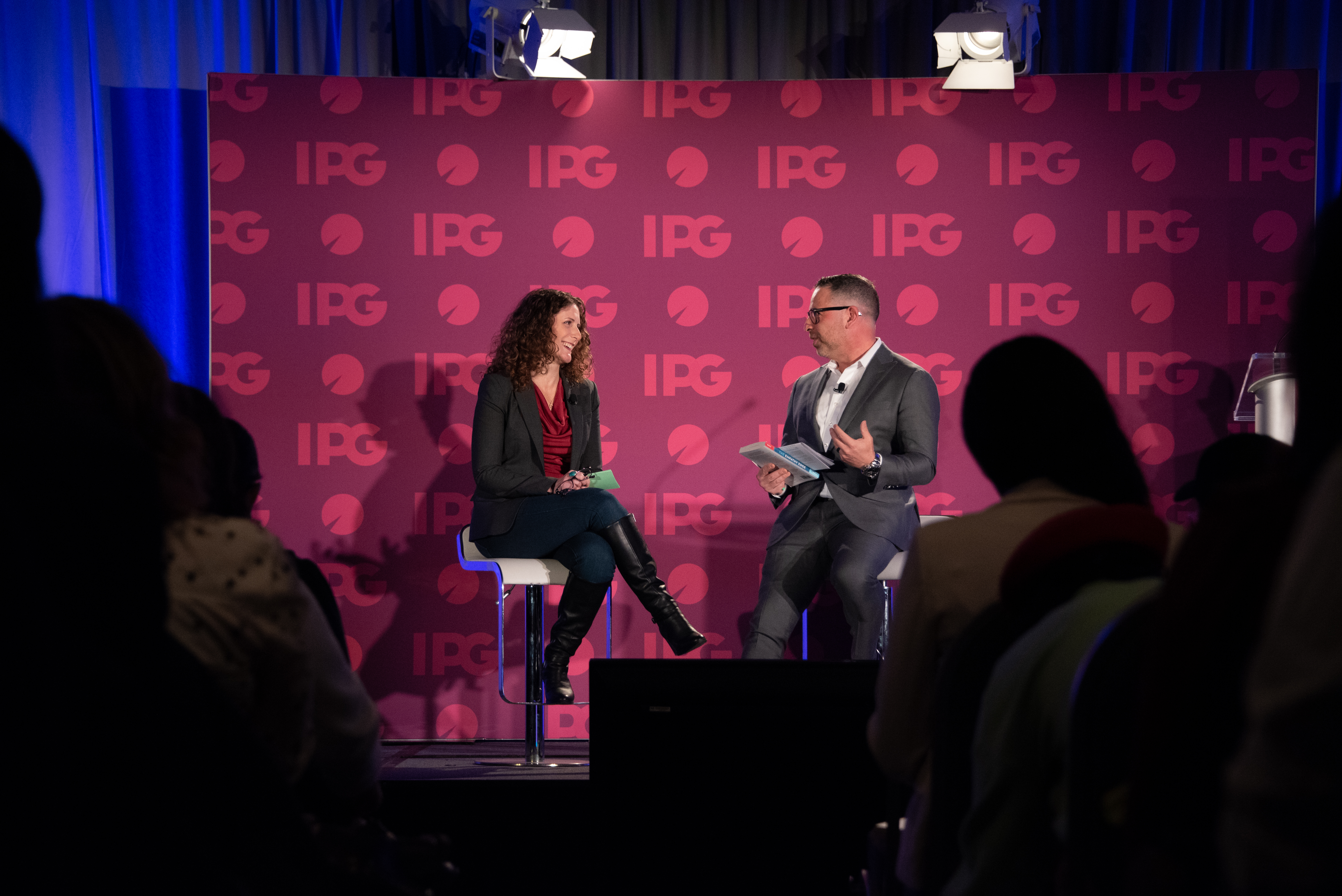
Paul Marobella was pumped to discuss Maria Ross’s new book, The Empathy Edge. These pages that prove empathy is great for business pair Ross’s knowledge as a branding expert with research from executives and changemakers.
The book is divided into four parts: why more businesses need to cultivate empathy, the empathetic leader, the empathetic culture, and the empathetic brand.
Ross started by grounding the room in what empathy means. “Empathy is really about taking another person’s perspective, understanding their point of view, and using that information to inform an action,” she explained. The action part is key.
Science says empathy is innate and hard-wired into human beings unless you’re a sociopath. “The whole 'I’m not an empathetic person' is BS,” she told the crowd. Think of it as working out. Some people work out their empathy muscles. Other people haven’t been to the gym in a while. You have to practice it and work on it.
The first 20 pages of The Empathy Edge tells the story of how Ross survived a ruptured brain aneurysm in 2008. Her experience in the hospital was amazing, and it wasn’t because of a bunch of nice people running around the hospital. It was by design.
According to Ross, the whole empathetic movement started because hospitals wanted to reduce patient readmission and malpractice suits. Policies and trainings were put into effect for “patient and family-centered care.” In the end, people felt heard, seen, cared for, and respected. The same principles can apply to any business.
Empathy isn’t about just giving somebody what they want. It’s about understanding the context of where someone is coming from. Why are they being short and rude? Maybe they are having a really bad day. Perhaps they’ve had a bad experience in the past and this project is bringing those feelings to the surface. If we slow down a bit to get to the why, then it could save us time and make us more successful in the long run.
Marobella asked Ross arguably the toughest question of the hour: How do you maintain empathy with a coworker or employee while staying highly competitive from a winning perspective? Ross offered two pieces of advice. First, practice presence. If you are stuck in your own ego, agenda, and anxiety then you have no room to see someone else’s perspective. You have to quiet your own mind so you can help others.
The second key is to be curious. When you disagree with someone in a meeting, find out why that person has an opposing view and how it could lead to success. Couple this curiosity with active listening. When you’re listening to understand versus to respond, you might find that you agree on something. Start from there.
"Treat people the way THEY want to be treated."
Ross further explained why empathy is important within companies: “Empathy is the glue that makes diversity work.” If we just stop at diversity, then we are just a bunch of different people at the table disagreeing. It’s not about the golden rule of treating people the way YOU want to be treated. It boils down to the platinum rule: treat people the way THEY want to be treated.
She also warned against fake empathy. Far too often, businesses try to appear empathetic on the outside, but their own backyard is a hot mess. Companies should focus on how they treat and value their own employees first.
I don’t know what we did to deserve more gems, but she dropped three keys to becoming an empathetic leader. To start, create an environment of trust. If people are too busy worrying about people stabbing them in the back, then their mental energy is not freed up to actually do their jobs.
Next, lead with humility. You are here to serve your people. They aren’t here to serve you.
Finally, ask how you can help your employees reach their goals. When people are failing, find out what’s going on for that person and get to the bottom of what might be getting in their way.
Empathy can also break down generational barriers. There are currently 4-5 generations in the workplace. According to a Deloitte study, millennials and Gen Z are the most empathetic generations at companies. They grew up having a voice, and they’re only going to work for organizations that allow their voices to be heard. In their eyes, empathy is no longer a competitive edge for a company. It’s just table stakes.
Younger generations are humanizing the workplace. They want a work culture that feels like a second family. “We should be thankful that the younger generations are changing this conversation because we were too scared to ask for it,” says Ross. And just like that, the mic might as well have been dropped.
Tell Me It Can’t Be Done and I’ll do It Twice and Take Pictures
Moderator: Kristin Hammerberg, Global VP, Business and Experience Design, Sid Lee
Panelists: Jennifer Putnam, Chief Creative Officer, Allen & Gerritsen
Kiana Pirouz Marketing Director, We are Rosie
Andrea Diquez CEO, Saatchi & Saatchi NY
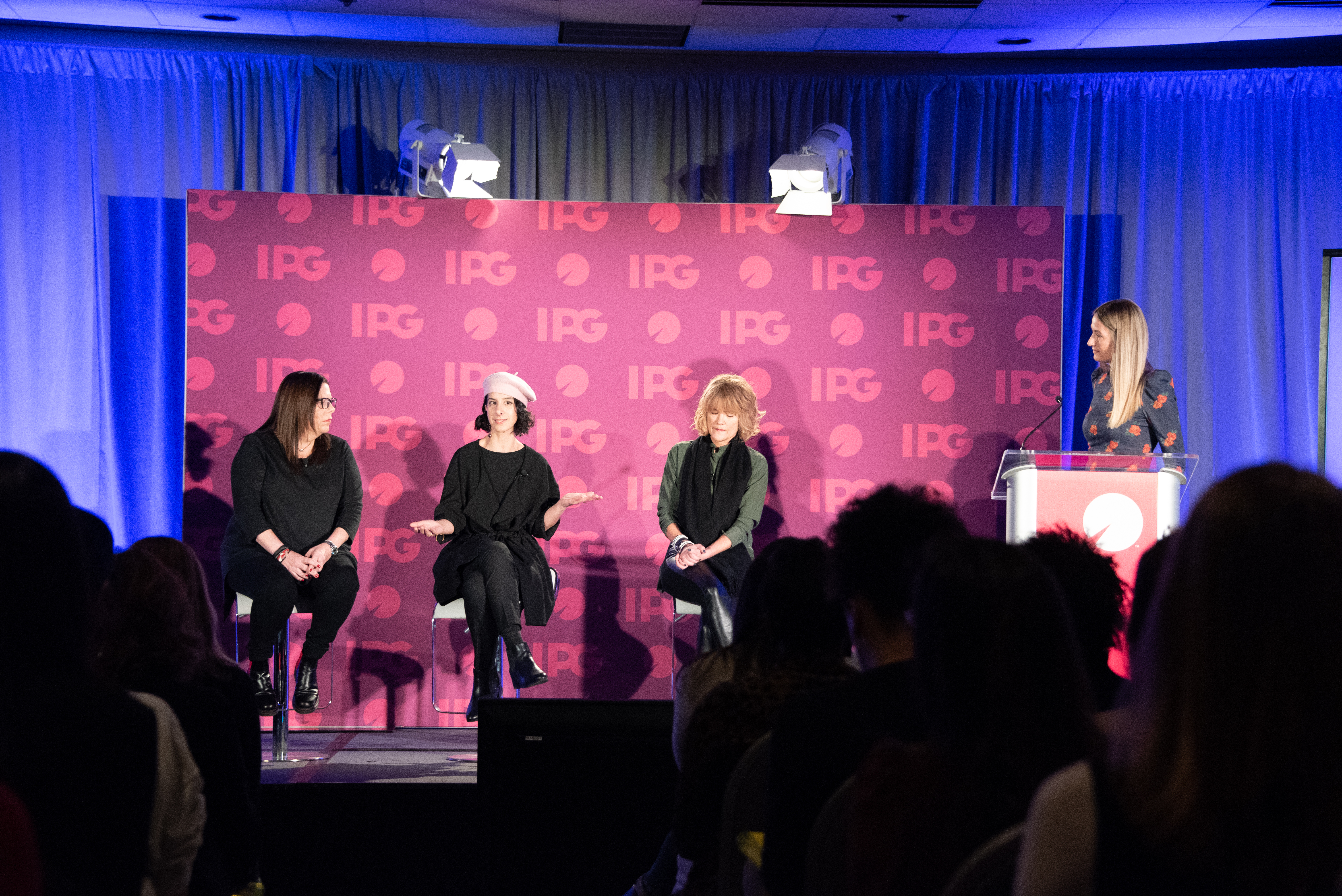
The crowd hooted and hollered as Kristin Hammerberg introduced three panelists for a bold conversation at the 3% Conference. Each woman shared her individual story of how adversity helped shape her leadership style.
Jennifer Putnam was up first. Her story began with a challenge she received from a CMO. Like any new CMO, her client was looking to shake things up. She had something up her sleeve but gave Putnam the option to say no if she wasn’t feeling it. “The minute you say ‘you can say no’, I know it’s something I’m going to want to do,” Putnam teased.
Instead of searching for a new agency, the CMO asked Putnam to put together a team of all freelancers to pitch their business. She requested that Putnam reach out to her network and do a broad talent search for a greater range of ideas on the account.
Putnam accepted the challenge with criteria of her own. First, diversity of talent and thought was a must. Next, collaboration would be key. Putnam also mandated that they run the pitch with transparency and humanity.
She eventually culled the applicants down to seven teams. Putnam was proud to say that there was a 50% balance between men and women and the LGBTQIA+ community was represented. What excited her even more is when she looked around the room every team member was over 40.
Notice anything missing here? Yes, people of color. Putnam admitted that they did not have much minority representation. Kudos to her for addressing the elephant in the room. Now let’s talk about it. While I applaud embracing an unconventional pitch process, the risky part about reaching out to your network, solely, is that it rarely includes everyone. We have to be careful that as we expand our diversity efforts, people of color, especially black people, aren’t being left behind.
Kiana Prouz was up next. She shared her journey to becoming the marketing director at the start-up We Are Rosie. Prouz worked in agencies for over a decade. She always found it strange that the team working on the brief didn’t quite represent the target audience. Eventually, Prouz became a Vice President and tried to use her position of power to shift the tide. After being met with overwhelming resistance, she decided to leave the agency.
Just when Prouz thought she might never find her home in the advertising industry, the founder of We Are Rosie reached out to her. She found her people. We Are Rosie pairs brands and agencies with diverse freelance talent to help tackle briefs. By pushing forward and meeting the resistance, they are making representation possible against all odds.
Next, Andrea Diquez dazzled the crowd. Diquez spoke on being from Venezuela and feeling naturally inclined to hire diverse talent. In her opinion, the issue is not getting diverse talent or meeting quotas. The issue is keeping the talent. “For that to happen you actually do need to change some policies and adapt the environment so that people can thrive,” she said.
Diquez explained that she is not a mother, but there are a lot of moms at her agency. She remembered telling one of her employees about to go on maternity leave that she would see her in 3-4 months. The employee informed her that maternity leave was actually six weeks. Diquez couldn’t believe it. So she decided to change it.
Once she expressed that she wanted to extend maternity leave, people simply said ok. It’s crazy how easy things can be sometimes if you just dare to ask. “If you’re the CEO it’s easy sometimes,” she joked. The crowd erupted into laughter. All jokes aside, we need more CEOs like her.
Diquez emphasized that you have to remove the barriers that people place on you. Sometimes you even have to remove the barriers that you place on yourself. No matter if you’re Black, Asian, Hispanic, or gay, people make you think these things are barriers, but it’s not true. Still, she acknowledged that some people have a tougher time removing those barriers than others.
The conversation shifted to a huge barrier in this industry. Like many women, Putnam experienced sexual harassment and sexism at the beginning of her career. Going through those experiences has inevitably made her a more empathetic leader and a better executive. She compared her approach to a slingshot. With every single challenge, she’s pulling the rock back and then going farther. At the end of the day, adversity builds resilience.
Prouz reminded us that it’s not about getting older and having thicker skin. It’s about becoming an advocate for that younger version of yourself. It’s about remembering that people are full humans in a system of leadership that tries to strip us of humanity.
"While we might not all have the privilege of risking it all, the least we can do is stand boldly in our truth."
Diquez casually encouraged bold action. You have to speak your mind. The worst they can do is fire you. They won’t kill you. You get two weeks of severance, and then you go get another job.
While we might not all have the privilege of risking it all, the least we can do is stand boldly in our truth.
The Evolving Role of the Chief Diversity Officer
Speaker: Tai Wingfield, Senior VP Webber Shandwick
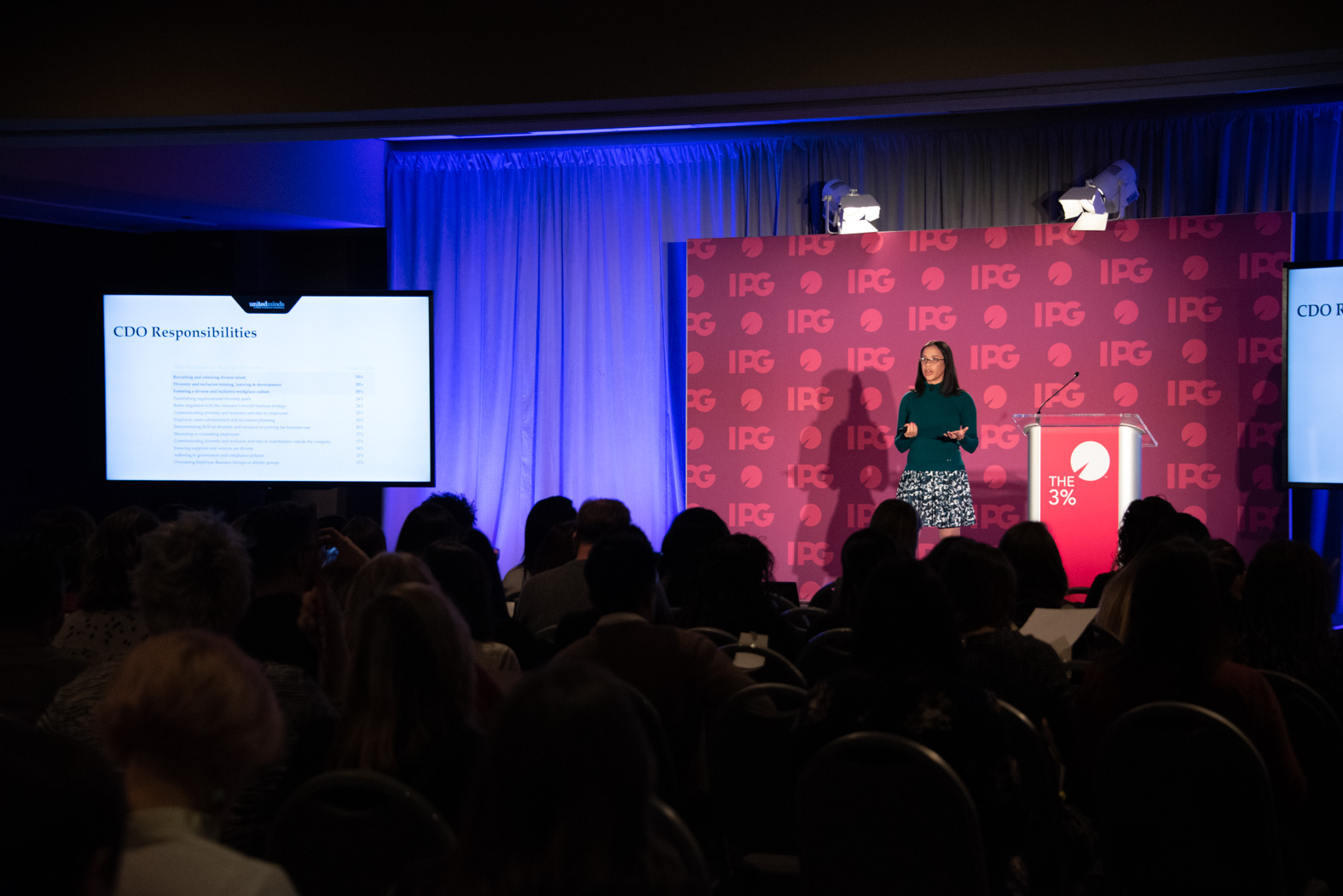
Every year, about 8 billion dollars is spent on diversity efforts at companies across the US. Yet somehow, the dollars aren’t adding up. Tai Wingfield shared her company’s research on the role of the Chief Diversity Officer (CDO) and where it is headed. Wingfield leads the diversity, equity, and inclusion offering at Weber Shandwick. The research they conducted includes surveys from 500 senior-level professionals responsible for diversity and inclusion (D&I) nationwide. Here are some of the key findings from the lunch and learn.
Diversity Starts at the Top
You would think that the person leading the charge for diversity might be diverse, at minimum. But surprisingly this is often not the case. Survey says, just like any other position in the C-Suite, the majority of CDOs are overwhelmingly white males. Not the typical white male leaders, though. Millennials and Gen X.
I’m going to go out on a limb and say that white men getting to the top of the corporate ladder younger and faster in positions tailor-made for diverse candidates isn’t quite the diversity push that we all had in mind. So how did we get here?
Like any other position in corporate America, CDOs have often appointed the role through internal recommendations. By now, the first step to evolving the role of the Chief Diversity Officer is probably crystal clear. Appoint a diversity and inclusion officer who is diverse themselves, even if that means looking outside of your company.
Personal Challenges Facing CDOs
A few things are getting in the way of CDOs reaching their goals. According to Weber Shandwick’s research, 27% of respondents say making the business case for D&I is the biggest struggle. While plenty of data and articles have been shared, they do not explain why D&I is good for their specific industry.
The second issue is making the business case for diverse mid-level managers. Think about a time when you were unhappy and left a company. More often than not, it was because you didn’t like working with a particular manager. Mid-level managers have a huge impact on company culture.
The last major roadblock CDOs encounter is making the company’s diversity and inclusion values known externally. As Wingfield put it, “If you’re not talking about it, no one knows.” Sharing your D&I efforts not only gives your company a competitive advantage but also brings others along the journey with you. You can get the word out by teaming up with your marketing and communications team.
Company Challenges Blocking CDOs
Organizational culture is the biggest company challenge facing CDOs. If done properly, D&I can be a major contributor to culture.
Additionally, internal support is needed to foster a diverse and inclusive environment. This means D&I has to be embedded across the organization. You’ll find internal support show up in different ways. For example, many companies have employee resource groups. These volunteer groups are a place for employees to come together and celebrate their differences while also partnering with their company to help drive business forward.
Another example of internal support is an advisory council comprised of senior leaders. The council’s job is to make sure they understand the D&I strategy and are driving it forward in their respective parts of the business.
Finally, support must come from mid-level managers. It’s their responsibility to demonstrate inclusive leadership and think about diversity and inclusion when they are making promotions and hiring decisions.
Align D&I to Your Business Strategy
Only 39% of D&I professionals felt that their efforts were aligned with their company’s business strategy. “Alignment doesn’t happen by accident. It is fostered deliberately through leadership, CEO support, financial accountability, and strategic communications,” shared Wingfield. Well-aligned functions realized three business advantages: a tangible outcome on new hires and resignations, a positive impact on company reputation and performance, and a competitive advantage.
Predictions & Conclusions
Companies are at a turning point with diversity and inclusion. Still, there’s a lot of work that needs to be done. D&I has to become more than that one executive’s job, but be fully woven into company culture. Heck, one day CDOs may even have a supporting staff of their own. You know, like any other department in the history of departments. When this happens then our workforce will start to mirror our country, and executive roles, even beyond Chief Diversity Officer, will become more diverse.
Shift Your View
Speakers: Adrienne Marcino, Director of Business Development, Terri & Sandy
Adrianne Smith, Founder Cannes Can Diversity Collective
Rebecca Weaver, Founder & CEO HRuprise
The clock was ticking, and each woman had approximately six and a half minutes to change the entire room’s view about their respective topics. That’s 20 slides with 20 seconds of commentary each, in a Japanese storytelling format known as Pecha Kucha. First up was one of two Adriennes.
Adrienne Marcino took the stage, and a few smiles and laughs into the presentation, we learned that Terry & Sandy is one of the few ad agencies that is creatively-led and women-owned. During her time there, Marcino found that people are actually more optimistic and effective at their jobs when they can bring their whole authentic selves to work. This theme proved to be a recurring topic throughout the conference. Marcino took the conversation a step further by sharing how authenticity at work can pour over into creative work, like in their “Strands for Trans” campaign.
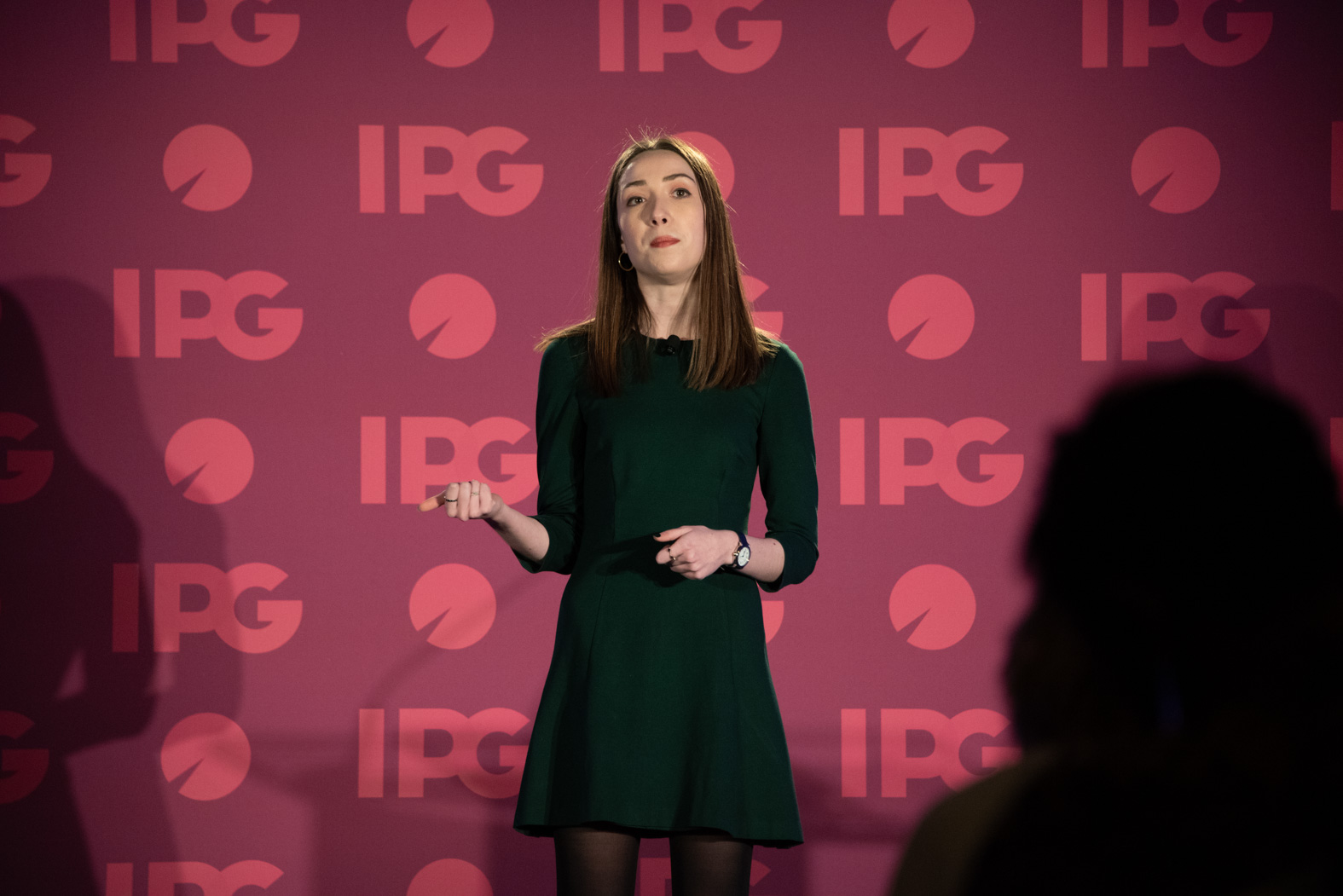
Terry & Sandy partnered with Barbra Men’s Grooming Boutique to create more trans-friendly barbershops and hair salons through the launch of “Strands for Trans.” The first step of this campaign was to let people know that discrimination against transgender people in these spaces exist. Then, they asked companies to register their barbershop or salon as a trans safe place. Barba Men’s Grooming Boutique even created a custom look inspired by the colors of the trans flag for people to rock during Pride Month.
"It was more than just adding a flag to a company’s profile."
At the end of the day, “Strands for Trans” was successful because people from the LGTBQIA+ community were involved throughout the entire process. It was more than just adding a flag to a company’s profile. It was about telling real stories with the power to impact their community in a meaningful way.
Next up was Adrianne Smith. “On the count of three everyone in the room say yes. One, two three,” Smith exclaimed. The crowd screamed, “Yes!” Smith proceeded, “Now let me tell you what you all just agreed to.” The crowd hung on to the edge of their seats waiting for the answer.
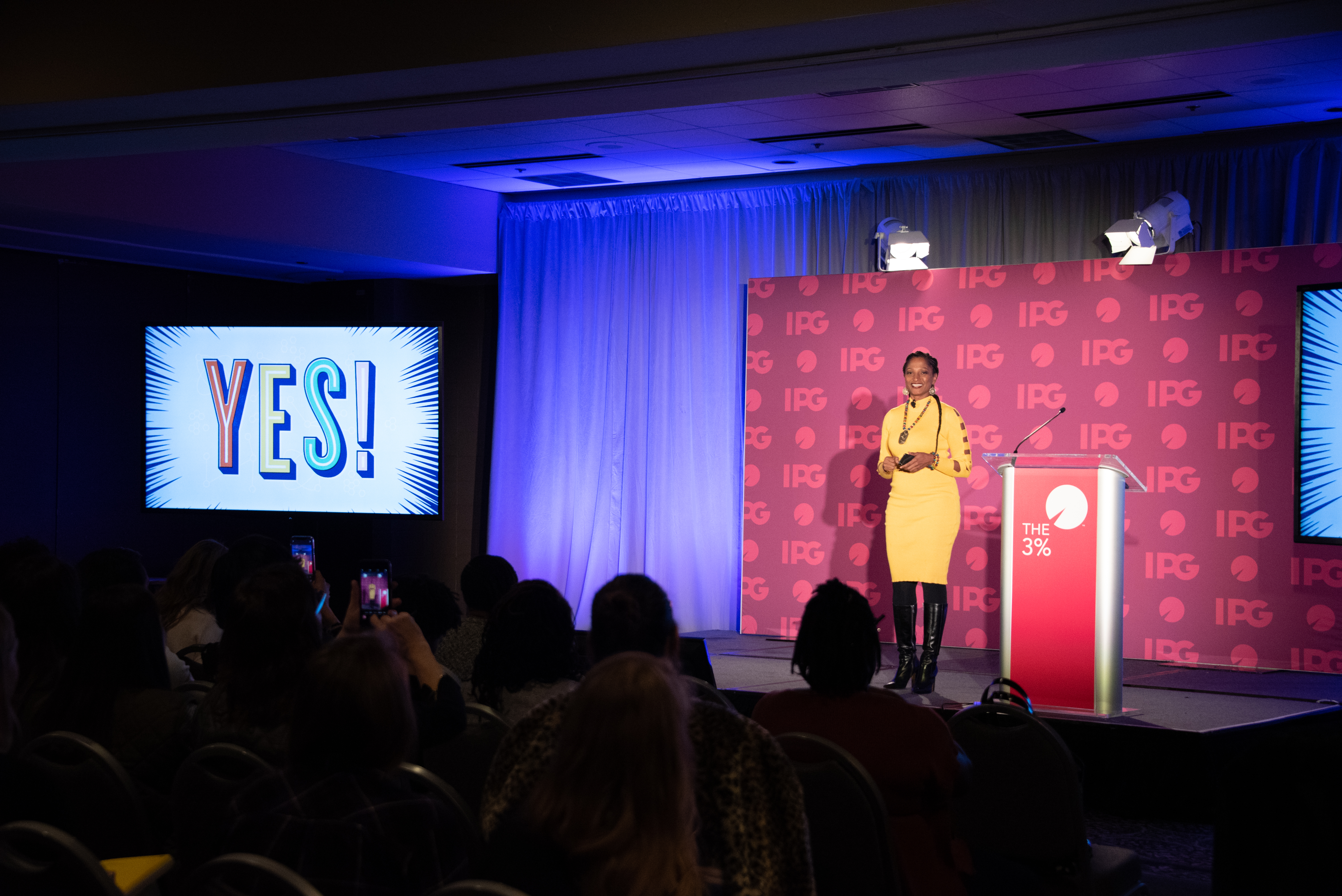
To their surprise, they had actually agreed to three things. First, be your authentic selves. Second, always be open and flexible to different ideas and opportunities. Last but not least, make Pecha Kucha great again.
Smith went on to share her personal experience of how she learned the importance of being your authentic self. She shared the realities of living in a part Christian, part Muslim household. Smith never had a Christmas tree, but she always had a Christmas couch. She never gave her Dad a Christmas present, but she always gave her Dad new socks and underwear around Christmas. Her very household was the quintessential example of how people can be who they are and still love and respect the people around them, no matter how different they are.
While Smith’s upbringing was very inclusive, she soon found out that the ad industry is not. She found that discrimination is 38% worse in the advertising industry compared to other industries. This reality led her to founding the Cannes Can Diversity Collective in 2017. She started the initiative to create opportunities for previously absent faces to be represented at the Cannes Lions International Festival of Creativity. Last year she brought five scholars to the festival, and in just a year the collective grew to 25 scholars and ambassadors in 2019.
Smith closed her lightning fast round with an urgent thought, “Now is the time, not the future.” Smith was hopeful, insisting that past diversity and inclusion initiatives have not failed, they just haven’t reached their full velocity.
"HR needs its soul back."
The final speaker of the session was Rebecca Weaver, Founder and CEO of HRuprise. Yep, it’s as rebellious as it sounds. Weaver used to work in HR, and she left when she wasn’t okay with how things were going down. Her position: HR needs its soul back. Here are a few themes that floated to the top.
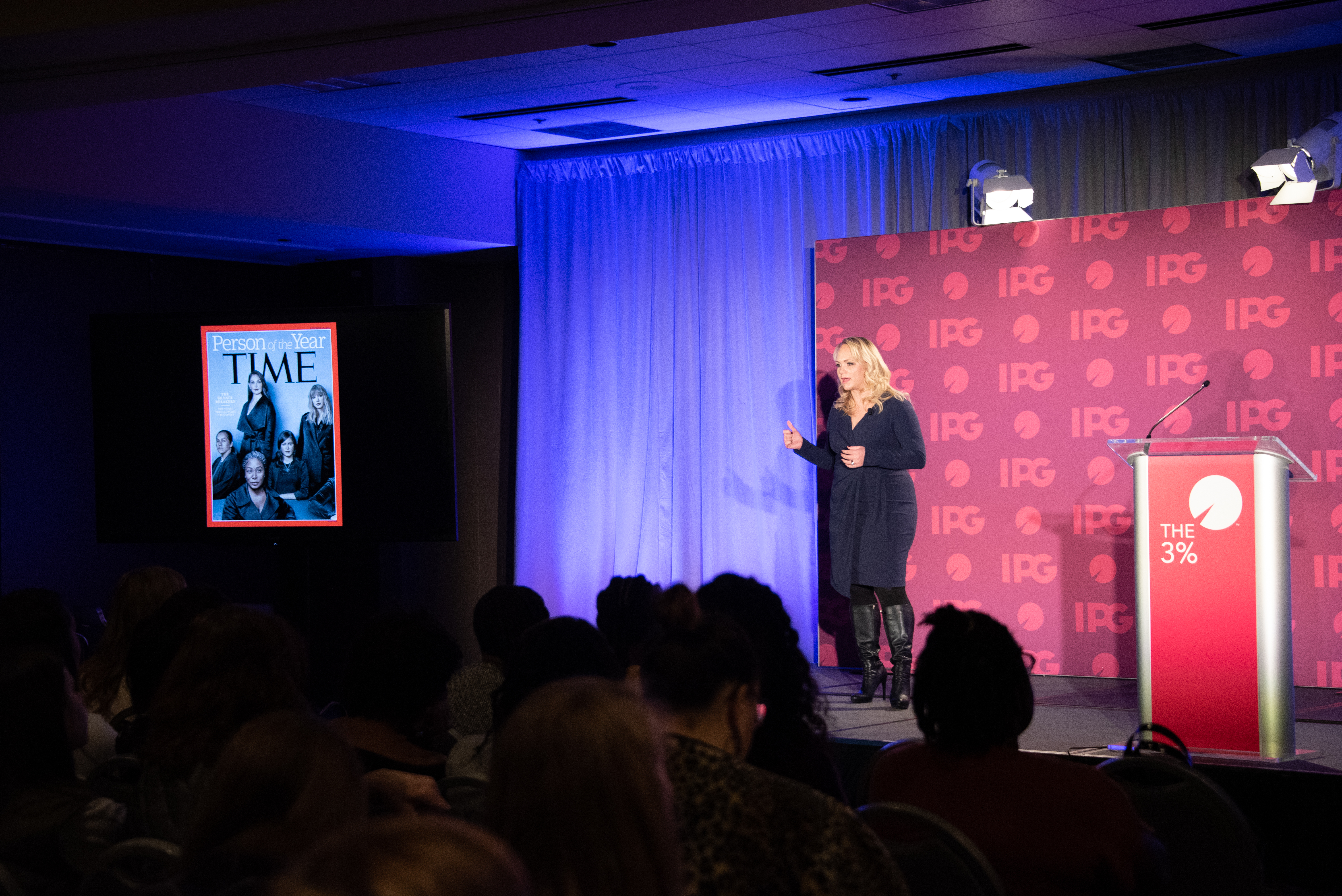
Trust in HR is at an all-time low. In fact, 70% of employees don’t trust HR. Judging by her presentation, it’s completely understandable why. At the end of the day, their primary obligation is to protect the company not the employees. She emphasized that this is a feature, not a bug. The system is designed to behave exactly the way it is now.
Weaver poked fun at the quintessential face of HR, “47-year old white woman. No word on how many cats she owns. One for me.” The crowd laughed. That’s right, HR has diversity issues, just like every other department.
She also raised the issue that too many roles are being forced into HR’s job description. She hopes to see a future where HR roles are further specialized. The same person responsible for employee development should not be responsible for investigating employee behavior. Weaver is a firm believer that diversity and inclusion should be separate.
Believe it or not, Weaver hopes to see a time where she is put out of business because industries finally have their act together. “Until then,” she said electrifying the crowd, “I’ll be out there leading the uprising.”




